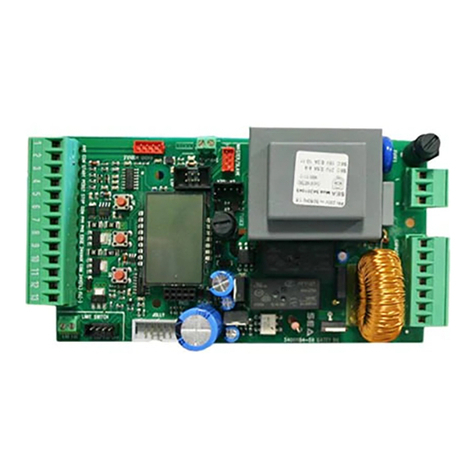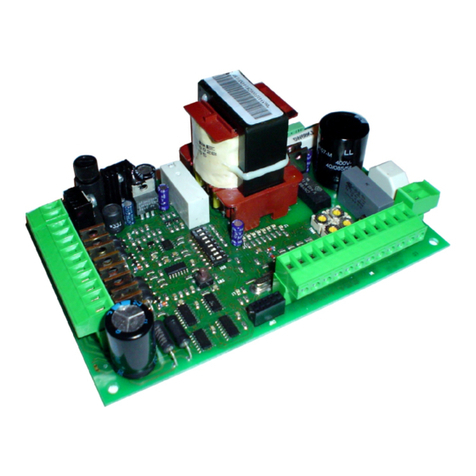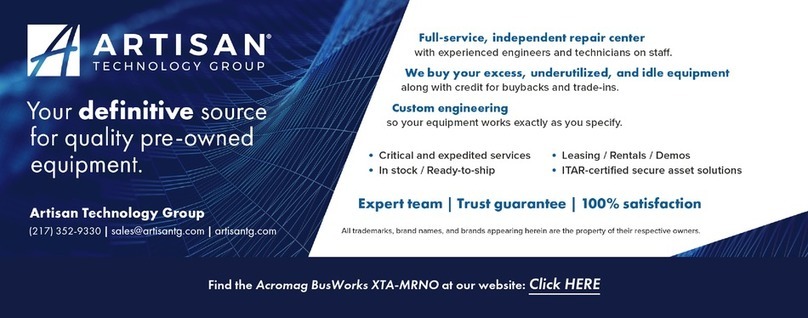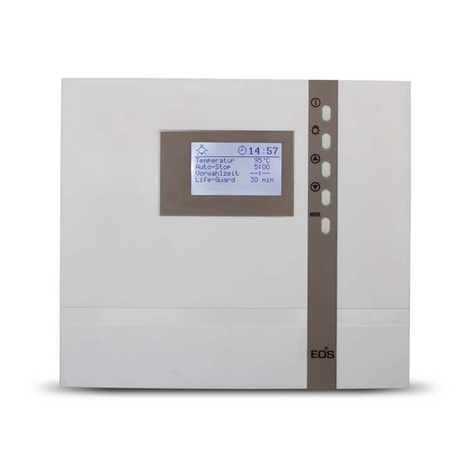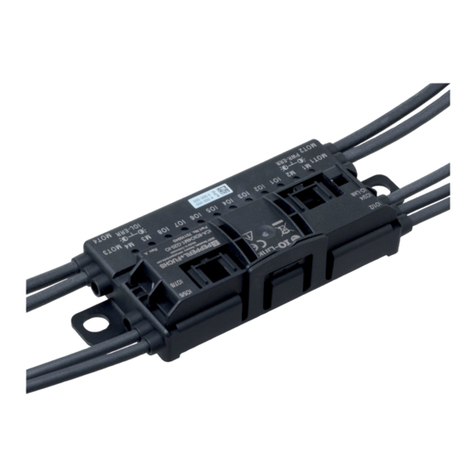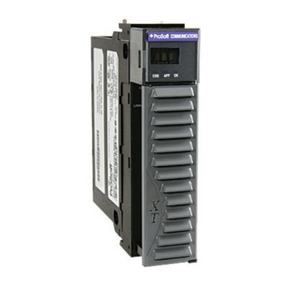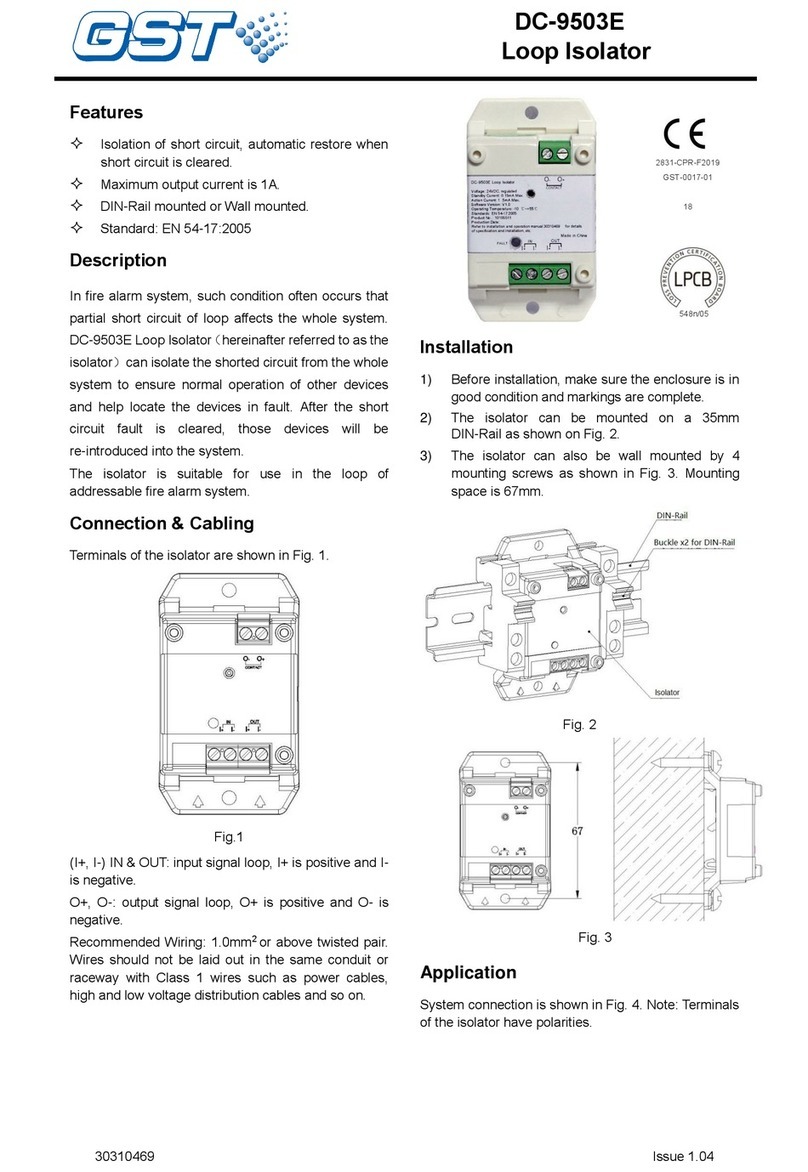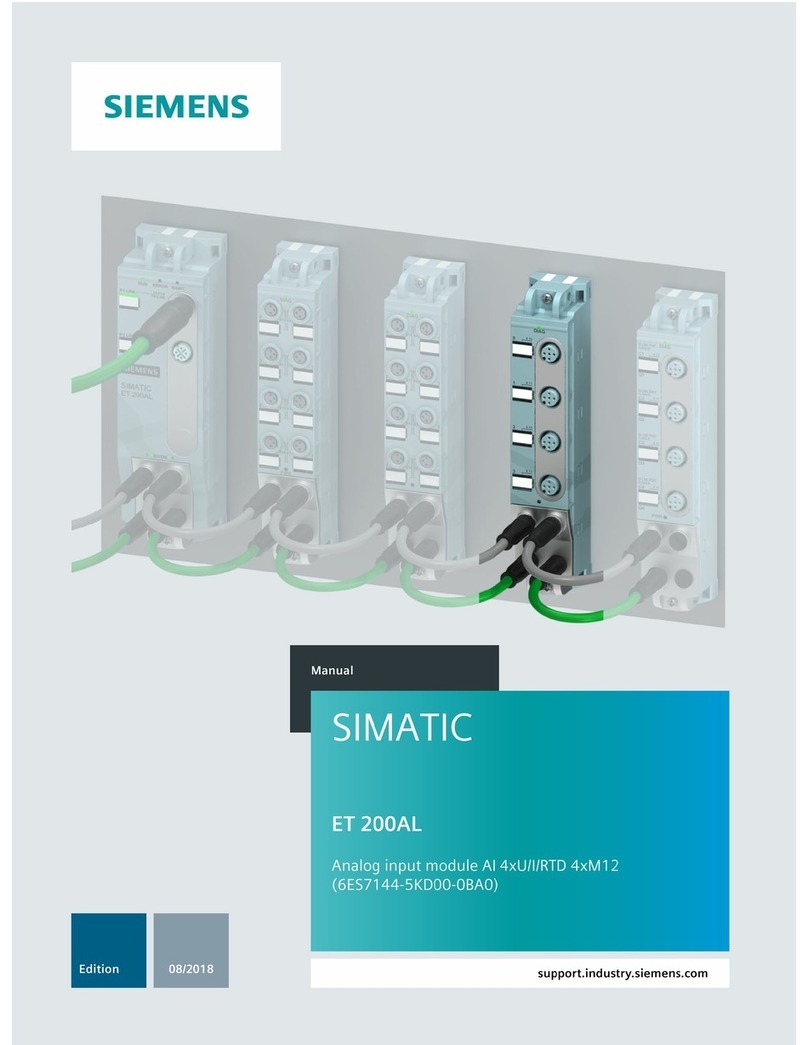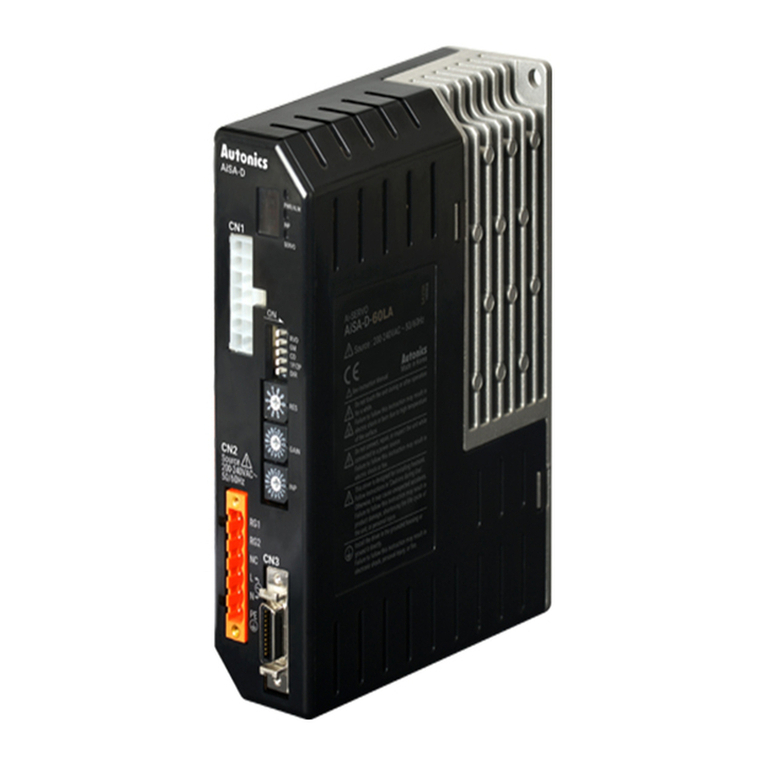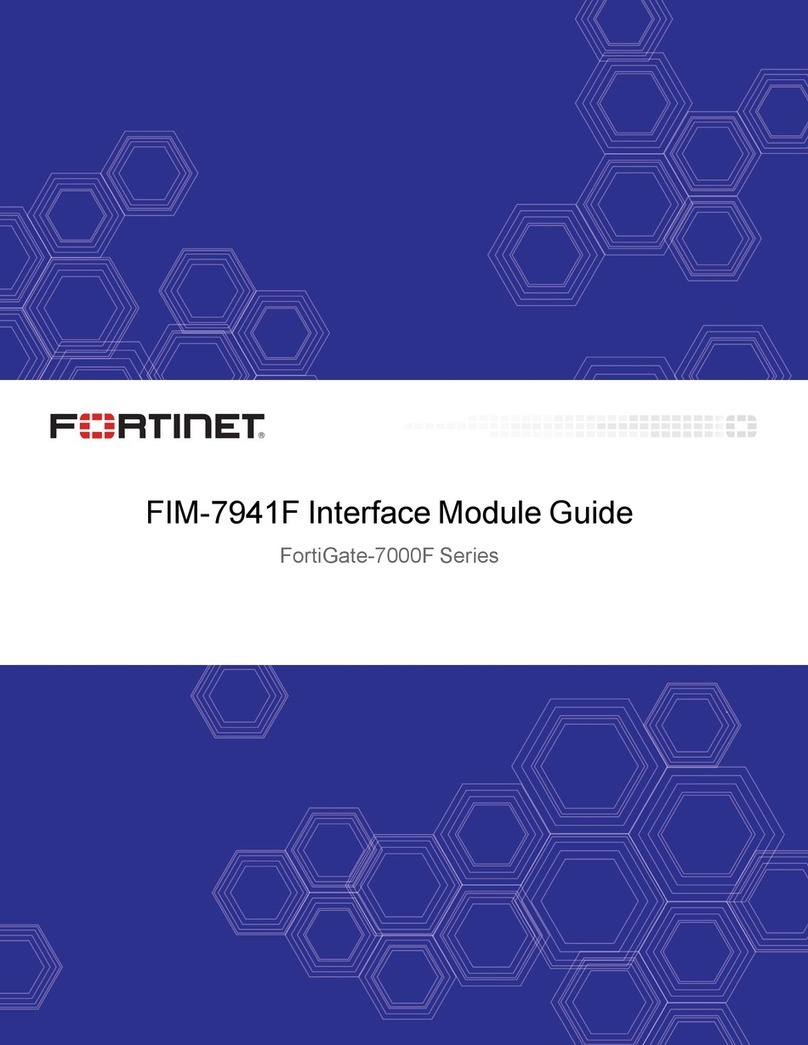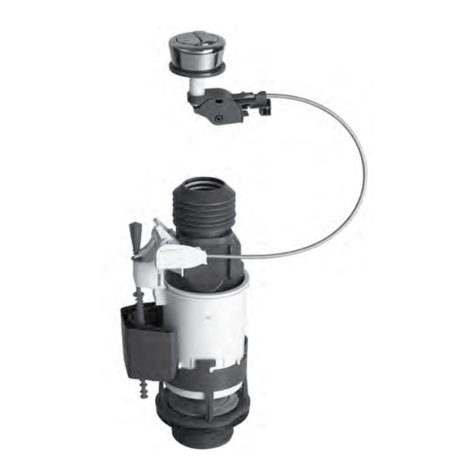SEA GATE 1 DG R2BF User manual

67410179 REV. 14 - 04/2021
GATE 1 DG R2BF
CONTROL UNIT FOR SLIDING GATES, SWING GATES, BARRIERS AND GARAGE DOORS
SEA USA Inc.
10850 N.W. - 21st - unit 160 - Doral - MIAMI
Florida (FL) - 33172 - USA
Telephone - : ++1-305.594.1151 ++1-305.594.7325
Toll free: 800.689.4716
www.sea-usa.com

IMPORTANT SAFETY INFORMATION
Clean and grease parts in movement (wheels, counter-connecting rod, release, etc.)
Check for corroded parts and replace if necessary
Check if the screws and all mounting hardwares are properly tighten
Check the conditions of wear and tear of the devices in movement
Check the correct drain of the rainwater
Check the integrity of the connection cables
Inspect the track for any signs of cracking or separation
Ensure that the gate moves freely
YEARLY
YEARLY
YEARLY
YEARLY
YEARLY
YEARLY
YEARLY
YEARLY
Check and confirm the proper operation of all safety devices (photocells, edge sensors etc)
Check and confirm the operation of all installed accessories
Check and confirm the operation of the manual release
Check the battery conditions and be sure that connections are free of corrosion
Verify the functionally of the battery backup, or power failure option
GENERAL SAFETY PRECAUTIONS
The following precautions are an integral and essential part of the product and must be supplied to the user;
Read them carefully as they contain important indications for the safe installation, use and maintenance.
1. These instruction must be kept and forwarded to all possible future users of the system.
2. This product must be used only for that which it has been expressly designed.
3. Any other use is to be considered improper and therefore dangerous.
4. The manufacturer cannot be held responsible for possible damage caused by improper or unreasonable use.
5. Avoid operating in the proximity of the hinges or moving mechanical parts.
6. Do not enter the path of the moving gate while in motion.
7. Do not obstruct the motion of the gate as this may cause a situation of danger.
8. Do not allow children to play or stay within the path of the moving gate.
9. Keep remote control or any other control devices out of the reach of children, in order to avoid possible involuntary
activation of the gate operator.
10. In case of break down or malfunctioning of the product, disconnect from the main power source. Do not attempt to
repair or intervene directly, contact only qualified personnel for repair.
11. Failure to comply with the above may create a situation of danger.
12. All cleaning, maintenance or repair work must be carried out by qualified personnel.
13. In order to guarantee that the system works efficiently and correctly it is important to have the manufacturer's
instructions on maintenance of the gate and operator carried out by qualified personnel.
14. In particular, regular checks are recommended in order to verify that the safety devices are operating correctly.
All installation, maintenance and repair work must be documented and made available to the user.
IMPORTANT SAFETY INSTRUCTIONS
WARNING – TO REDUCE THE RISK OF INJURY OR DEATH:
1. READ AND FOLLOW ALL INSTRUCTIONS.
2. Never let children operate or play with gate controls. Keep the remote control away from children.
3. Always keep people and objects away from the gate. NO ONE SHOULD CROSS THE PATH OF THE MOVING GATE.
4.Test the gate operator monthly. The gate MUST reverse on contact with a rigid object or stop when an object
activates the non-contact sensors. After adjusting the force or the limit of travel, retest the gate operator. Failure to
adjust and retest the gate operator properly can increase the risk of injury or death.
5. Use the emergency release only when the gate is not moving
6. KEEP GATES PROPERLY MAINTAINED. Read the owner’s manual. Have a qualified service person make repairs to
gate hardware.
7. The entrance is for vehicles only. PEDESTRIANS MUST USE SEPARATE ENTRANCE.
8. Every gate operator installation MUST have secondary protection devices agains entrapments, such as edge
sensors and photo beams more in particulary in places where the risk of entrapments is more likely to occur
9. SAVE THESE INSTRUCTIONS
OPERATORS PERIODIC MAINTENANCE
TURNING OFF THE POWER
BY MAIN SOURCE TURNED-OFF
TURNING ON THE POWER
!
YEARLY
YEARLY
YEARLY
YEARLY
YEARLY
ALL THE ABOVE DESCRIBED OPERATIONS MUST BE MADE EXCLUSIVELY BY AN AUTHORIZED INSTALLER
2

GENERAL SAFETY INFORMATION
An appliance shall be provided with an instruction manual.
The instruction manual shall give instructions for the installation, operation, and user maintenance of the appliance.
The installation instructions shall specify the need for a grounding-type receptacle for connection to the supply and
shall stress the importance of proper grounding.
The installation instructions shall inform the installer that permanent wiring is to be employed as required by local
codes, and instructions for conversion to permanent wiring shall be supplied.
INFORMATION SHALL BE SUPPLIED WITH A GATE OPERATOR FOR:
a. The required installation and adjustment of all devices and systems to effect the primary and secondary protection
against entrapment (where included with the operator).
b. The intended connections for all devices and systems to effect the primary and secondary protection against en-
trapment. The information shall be supplied in the instruction manual, wiring diagrams, separate instructions, or the
equivalent.
VEHICULAR GATE OPERATORS (OR SYSTEMS)
A vehicular gate operator shall be provided with the information in the instruction manual that defines the different
vehicular gate operator Class categories and give examples of each usage. The manual shall also indicate the use for
which the particular unit is intended as defined in Glossary, Section 3. The installation instructions for vehicular gate
operators shall include information on the Types of gate for which the gate operator is intended.
A gate operator shall be provided with the specific instructions describing all user adjustments required for proper
operation of the gate. Detailed instructions shall be provided regarding user adjustment of any clutch or pressure relief
adjustments provided. The instructions shall also indicate the need for periodic checking and adjustment by a qualified
technician of the control mechanism for force, speed, and sensitivity.
Instructions for the installation, adjustment, and wiring of external controls and devices serving as required protection
against entrapment shall be provided with the operator when such controls are shipped with the operator.
Instructions regarding intended installation of the gate operator shall be supplied as part of the installation instructions
or as a separate document. The following instructions or the equivalent shall be supplied where applicable:
IMPORTANT INSTALLATION INSTRUCTIONS
1. Install the gate operator only when:
a. The operator is appropriate for the construction of the gate and the usage Class of the gate
b. All openings of a horizontal slide gate are guarded or screened from the bottom of the gate to a minimum of 4 feet
(1.22 m) above the ground to prevent a 2-1/4 inch (57.2 mm) diameter sphere from passing through the openings
anywhere in the gate, and in that portion of the adjacent fence that the gate covers in the open position
c. All exposed pinch points are eliminated or guarded
d. Guarding is supplied for exposed rollers
2. The operator is intended for installation only on gates used for vehicles. Pedestrians must be supplied with a
separate access opening. The partial access opening shall be designed to promote pedestrian usage. Locate the gate
such that persons will not come in contact with the vehicular gate during the entire path of travel of the vehicular gate.
3. The gate must be installed in a location so that enough clearance is supplied between the gate and adjacent
structures when opening and closing to reduce the risk of entrapment. Swinging gates shall not open into public access
areas.
4. The gate must be properly installed and work freely in both directions prior to the installation of the gate operator. Do
not over-tighten the operator clutch or pressure relief valve to compensate for a damaged gate.
5. The gate operator controls must be placed so that the user has full view of the gate area when the gate is moving and
AWAY FROM THE GATE PATH PERIMETER.
6. Controls intended for user activation must be located at least six feet (6’) away from any moving part of the gate and
where the user is prevented from reaching over, under, around or through the gate to operate the controls. Outdoor or
easily accessible controls shall have a security feature to prevent unauthorized use.
7. The Stop and/or Reset button must be located in the line-of-sight of the gate. Activation of the reset control shall not
cause the operator to start.
8. A minimum of two (2) WARNING SIGNS shall be installed, one on each side of the gate where easily visible
9. FOR GATE OPERATORS UTILIZING A NON-CONTACT SENSOR:
a. See instructions on the placement of non-contact sensors for each Type of application
b. Care shall be exercised to reduce the risk of nuisance tripping, such as when a vehicle, trips the sensor while the
gate is still moving
c. One or more non-contact sensors shall be located where the risk of entrapment or obstruction exists, such as the
perimeter reachable by a moving gate or barrier
3

10. FOR A GATE OPERATOR UTILIZING A CONTACT SENSOR:
a. One or more contact sensors shall be located where the risk of entrapment or obstruction exists, such as at the
leading edge, trailing edge, and postmounted both inside and outside of a vehicular horizontal slide gate.
b. One or more contact sensors shall be located at the bottom edge of a vehicular vertical lift gate.
c. One or more contact sensors shall be located at the pinch point of a vehicular vertical pivot gate.
d. A hardwired contact sensor shall be located and its wiring arranged so that the communication between the sensor
and the gate operator is not subjected to mechanical damage.
e. A wireless contact sensor such as one that transmits radio frequency (RF) signals to the gate operator for
entrapment protection functions shall be located where the transmission of the signals are not obstructed or
impeded by building structures, natural landscaping or similar obstruction. A wireless contact sensor shall
function under the intended end-use conditions.
f. One or more contact sensors shall be located on the inside and outside leading edge of a swing gate. Additionally, if
the bottom edge of a swing gate is greater than 6 inches (152 mm) above the ground at any point in its arc of travel,
one or more contact sensors shall be located on the bottom edge.
g. One or more contact sensors shall be located at the bottom edge of a vertical barrier (arm).
INSTRUCTION REGARDING INTENDED OPERATION OF THE GATE OPERATOR SHALL BE PROVIDED AS PART OF THE USER
INSTRUCTIONS OR AS A SEPARATE DOCUMENT. THE FOLLOWING INSTRUCTIONS OR THE EQUIVALENT SHALL BE PROVIDED
NOTICE
As for misunderstandings that may arise refer to your area distributor or call our help desk. These instructions are part
of the device and must be kept in a well known place. The installer shall follow the provided instructions thoroughly.
SEA products must only be used to automate doors, gates and wings. Any initiative taken without SEA USA Inc. explicit
authorization will preserve the manufacturer from whatsoever responsibility. The installer shall provide warning notices
on not assessable further risks. SEA USA Inc. in its relentless aim to improve the products, is allowed to make
whatsoever adjustment without giving notice. This doesn’t oblige SEA to up-grade the past production. SEA USA Inc.
can not be deemed responsible for any damage or accident caused by product breaking, being damages or accidents
due to a failure to comply with the instructions herein. The guarantee will be void and the manufacturer responsibility
will be nullified if SEA USA Inc. original spare parts are not being used. The electrical installation shall be carried out by
a professional technician who will release documentation as requested by the laws in force. Packaging materials such
as plastic bags, foam polystyrene, nails etc must be kept out of children’s reach as dangers may arise.
TO RESPECT THE LAWS IN FORCE IT IS RECOMMENDED TO USE THE ENCODER WITH THE ELECTRONIC CONTROL UNIT
UL 325 ED. 6th ENTRAPMENT PROTECTION REQUIREMENTS
VEHICULAR GATE OPERATOR CLASSES
Residential Vehicular Gate Operator-Class I: A vehicular gate operator (or system) intended for use in garages or
parking areas associated with a residence of one-to-four single families
Commercial/General Access Vehicular Gate Operator-Class II: A vehicular gate operator (or system) intended for
use in a commercial location or building such as a multi-family housing unit (five or more single family units), hotel,
garages, retail store, or other buildings accessible by or servicing the general public
Industrial/Limited Access Vehicular Gate Operator–Class III: A vehicular gate operator (or system) intended for
use in an industrial location or building such as a factory or loading dock area or other locations not accessible by or
intended to service the general public
Restricted Access Vehicular Gate Operator–Class IV: A vehicular gate operator (or system) intended for use in an
industrial location or building such as a factory or loading dock area or other locations not accessible by or intended to
service the general public
THIS VEHICULAR GATE OPERATOR MUST BE INSTALLED WITH AT LEAST TWO INDEPENDENT ENTRAPMENT PROTECTION MEANS
AS SPECIFIED IN THE TABLE BELOW
HORIZONTAL SLIDE
VERTICAL LIFT - VERTICAL PIVOT
ENTRAPMENT
PROTECTION
TYPES
TYPE A
TYPE B1
TYPE B2
TYPE C
Inherent entrapment protection system
Non-contact sensors such as photoelectric sensors or equivalents
Contact sensors such as edge sensors or equivalent devices
Inherent force limiting, inherent adjustable clutch or inherent pressure relief device
TYPE D Actuating device requiring constant pressure to maintain opening or closing motion of the gate
SWING
VERTICAL BARRIER (ARM)
A , B1*, B2* or D A , B1*, B2*, C or D
GATE OPERATORS CATEGORY (Effective January, 12 2016)
4

NOTES:
1. The same type of device shall not be used for both entrapment protection means. Use of a single device to cover both
the opening and closing directions is in accordance with the requirement; however, a single device is not required to
cover both directions. Tice installer is required to install entrapment protection devices in each entrapment zone
2. FOR VERITICAL BARRIERS ONLY: Barrier gate operators (arm) that is not intended to move toward a rigid objact
closer than 16 inches (406 mm) are not required to be provided with a means of entrapment protection
* B1 and B2 means of entrapment protection MUST be MONITORED
Changes to UL 325 ED. 6th for Gate Operators
Starting on Jan. 12, 2016, new UL 325 changes take effect, bringing a series of new mandates for the gate
operator industry. Here’s a quick guide to the key modifications
1. ENTRAPMENT-PROTECTION DEVICES: Gate operators are required to have a minimum of two independent means of
entrapment protection where the risk of entrapment or obstruction exists. A manufacturer can use two inherent-type
systems, two external-type systems, or an inherent and an external system to meet the requirement. However, the
same type of device cannot be used for both means of protection.
2. MONITORING REQUIRED: An external non-contact sensor or contact sensor may be used as a means of entrapment
protection. However, the sensor must be monitored once every cycle for:
a. the correct connection to the operator
b. the correct operation of the sensor
If the device is not present, not functioning, or is shorted, then the gate operator can only be operated by constant
pressure on the control device. Portable wireless controls will not function in this case.
3. ENTRAPMENT RISK IDENTIFICATION: As in the past, it’s up to the installer to examine the installation and determine
where a risk of entrapment or obstruction exists. Manufacturers are required to provide instructions for the placement
of external devices, but they give only examples of suggested entrapment protection in their installation manuals. If the
installer identifies a risk of entrapment or obstruction, at least two independent means of entrapment protection are
required.
4.TERMINOLOGY CHANGE: The terms «primary» and «secondary» have been removed in the description of entrapment
protection devices. This was done to emphasize that all entrapment protection devices are equally important.
5. THE END OF TYPE E: Type E (audible alarm) devices can no longer be used for entrapment protection. This change
was made because the Type E device is really a warning device, not an entrapment-protection device. Also, all gate
operator classes are now required to have an audio alarm that sounds when two successive obstructions are
encountered via a contact-type system.
6. ACCESS CONTROL LOCATION FOR EMERGENCY USE: An exception has been added in the manufacturer’s instructional
requirements for the location of controls that operate the gate.
The instructional requirements state that these controls must be at least 6' away from any moving part of the gate. In the
new exception, «Emergency access controls only accessible by authorized personnel (e.g., fire, police, EMS) may be
placed at any location in the line-of-sight of the gate».
7. BARRIER-ARM OPERATOR EXCEPTION: An exception has changed for barrier-arm gate operators requiring entrapment
protection. The previous exception stated that a barrier-arm operator did not require entrapment protection if the arm
did not move toward a rigid object closer than 2". The distance has been reduced to 16" so it more closely aligns with the
industry-defined entrapment protection provisions in ASTM F2200.
8. GATE OPERATOR CLASS II AND CLASS III DEFINITIONS: The definitions for installation classes for gate operators were
modified. Class II now includes commercial locations accessible to the general public. Class III was refined to specify
industrial locations not accessible to the general public. These changes, while seemingly minor, may affect which gate
operator is suitable for a particular installation location.
5

1
2
3
3.1
3.2
3.3
3.4
3.5
3.6
3.7
3.8
3.9
3.10
3.11
3.12
3.13
3.14
4
4.1
4.2
4.3
5
5.1
6
6.1
7
7.1
Connections
Jumpers
Connections on CN1
Start
Partial opening Start
Stop
Photocells 1 and 2
24V AUX
Timer
Flashing lamp
Safety edge
10K Photocell
Buzzer
Safety loop
Relay on 24VAUX output
External receiver
Latch opening/closing
Connections on CN2
Motor connection
Three-phase module
Courtesy light
Connections on CN3
Control unit power supply
Connections on CN4
Synchronized photocells
Connections on CN5
Encoder
INDEX
8
8
9
9
9
9
9
9
9
10
10
10
10
11
11
12
12
12
12
13
13
13
13
13
13
14
14
CHAPTER PAGE
14
14
14
15
15
16
16
16
16
17
18
18
18
19
20
21
23
25
25
26
28
38
CHAPTER PAGE
8
8.1
8.2
9
9.1
10
11
11.1
11.2
11.3
12
12.1
12.2
13
14
15
16
17
18
19
--
--
Connections on CN6/CN7
Pre-wired limit switch
Non pre-wired limit switch
Connections on CMS
Master / Slave
RECEIVERS on CNA/CNS
Connections on EXP
SEM 2 management unit
Temperature probe
Potentiometer
Additional functions
Amperometric management
Surge Protector circuit
Display/programming
Basic Menu
Input management
Working times
Logics
Password
Receivers - remote controls
Menu table
Alarms indications
6

INPUT OUTPUT
MOTOR
CAPACITOR
COUTESY LIGHT
POWER SUPPLY
24V~
ENCODER
PRE-WIRED
LIMIT-SWITCH
NOT PRE-WIRED
LIMIT-SWITCH
RX RECEIVER
RF FIX RECEIVER
PROGRAMMING
EXTERNAL MODULE
MASTER / SLAVE
JOLLY 3
SEACLOUD
MOTOR CONTROL
TRIAC
COURTESY LIGHT
AND MOTOR RELAY
MOTOR EXCHANGE
RELAY
FUSE 6.3AT ON 230V
10AT ON 115V
1A ACCESSORIES
FUSE
POWER
TRANSFORMER
POWER SUPPLY
WORKING TEMPERATURE
STAND-BY ABSORPTION
EXTERNAL BOX
6,10 inches
3,35 inches
--------
--------
--------
--------
-
-
DISPLAY
CN1
14 15 16 17 18 19 20
N
98
7
6
5
4
3
2
110 13
12
11
R1
F1
T1
R2
CN6CN7
JOLLY 3
CNA CNSCNS
EXP
CN4
CNP
UP DOWN OK
CMS
TR1
CN5
CN3 CN2
F2
L
CN1
CN2
CN3
CN4
CN5
CN6
CN7
CNA
CNS
CNP
EXP
CMS
JOLLY
T1
R1
R2
F1
F2
TR1
COMPONENTS
230 Vac 50/60 Hz
115Vac 50/60 Hz
30 mA
7,20x9,37x4,72 inches
IP55
TECHNICAL DATA
-4°F +122°F
7

Partial opening Start
Photocell 2
Safety Edge
Common
Common
Photocell 1
1 - CONNECTIONS
Italiano
ENGLISH
International registered trademark n. 804888
3 - JUMPERS
OPTIONAL
Start
Stop
Antenna
Flashing lamp (-)
AUX
* (24V 500 mA max)
* 24V 500 mA max
(Accessories)
Opening Limit Switch (green)
Closing Limit Switch (yellow)
Common (white)
* 24V (red)
Common
Opening Limit Switch (green)
Closing Limit Switch (yellow)
* The maximum indicated load of 500 mA refers to the maximum load distributed
on all 24V outputs included the absorption of the receiver on board (30 mA)
On the 24V AUX output it is possible to connect a maximum load of 500 mA
WARNING: The control unit is designed
for the automatic detection of not used
N.C. inputs (Photocells, Stop and Limit
switch) except for the SAFETY EDGE
input. The excluded inputs during the
self-programming can be restored
through the «INPUT STATUS CHECK»
menu (chapter 15) without need to repeat
the control unit programming
NOTE:
The herein reported functions are available starting from Software Revision 03.03 of this
control unit and it is compatible with JOLLY 3 programmer
2 - JUMPERS
CN1
98
7
6
5
4
3
2
110 13
12
11
CN4
24Vac *
Max. 150 mA
CN5
CN6
1
CN1
98
7
6
5
4
3
2
110 13
12
11
+
-
+
-
+
-
+
-
14 15 16 17 18 19 20
CN2
M
ENCODER
ANT COM START PEDST STOP COM PH1 PH2 EDGE 24VAUX COM 24V(FL) (FL)-
Courtesy light (phase)
LIGHT LIGHTN MCL MN MOP CAPACITOR
Courtesy light (neutral)
Closing Motor 1
Neutral Motor 1
Opening Motor 1
Motor 1 capacitor
CNA
RADIO MODULE
CONNECTOR
PROGRAMMING
BUTTONS
UP DOWN OK
EXTERNAL MODULE
CONNECTOR
EXP
CNS CNP
OPEN PROGRAMMER
(Firmware update)
JOLLY 3
JOLLY3/SEACLOUD
CONNECTOR
CN7
CN3
N
Neutral
Line
L
green or black
white or blue
brown or red
1
Partial opening Start
Photocell 2
Safety Edge
Common
Common
Photocell 1
Start
Stop
Antenna
Flashing lamp (-)
AUX
* (24V 500 mA max)
* 24V 500 mA max
(Accessories)
Common
WARNING: CONNECT ALL DEVICES WITH SWITCHED-OFF CONTROL UNIT
8

3 - CONNECTIONS ON CN1
Common
Common
Photocell 1
Common
Photocell 2
Partial Opening START
Italiano
ENGLISH
International registered trademark n. 804888
TX1
TX2
24V
CN1
13
12
11
10
9
CN1
8
7
6
5
4
3
2
1
Start
Stop
Antenna
RX1
RX2
3.1 - START (N.O.)
On clamps 2 and 3
The automation can be opened or closed through an impulse
transmitted to this input (via key button, keyboard, etc.). To
connect other Start devices (for ex. the magnetic loop) refer to
the respective instructions
Note 1: For details on the logics that can be associated to the
START button, see chapter 17 (LOGICS)
Note 2: If this contact is engaged during the pause (eg. Timer),
the gate will not close until releasing
3.2 - PARTIAL OPENING START (N.O.)
On clamps 2 and 4
The input allows to obtain the partial opening. It is possible to
manage the opening space through the menu-90 or through
the JOLLY 3. It is also possible to manage the partial opening
pause time through the menu- 91
Note 1: For details on the logics that can be associated to the
PARTIAL OPENING START button, see chapter 17 (LOGICS)
Note 2: If this contact is engaged during the pause (eg. Timer),
the gate will not close until releasing
3.3 - STOP (N.C.) On clamps 5 and 6
If this button is pressed the engine stops immediately in whatever condition or position it is. A new Start
command will be required to restore the movement.
Note: After the Stop command, the engine will always re-start in closing
3.4 - PHOTOCELL 1 AND PHOTOCELL 2
+ = 24V max 500mA (clamp 12) COM = 0V (clamps 2 - 6 - 11)
Ph1 = Photocell 1(clamp 7) PH2 = Photocell 2 (clamp 8)
Note 1: To perform the self-test, connect the TX positive to the clamp 10 (AUX) and activate the Phototest
function on menu-94; From the 95-PHOTOTEST menu it is possible to activate the self-test also on a
single photocell, choosing from the menu options.
Note 2: The default settings are: 97-PHOTOCELL 1 = «closing»; 98-PHOTOCELL 2 = «opening»;
for further functions and management, see menu-97 and menu-98
3.6 - TIMER (N.O.)
On clamp 4 (Partial Opening Start) or on clamp 8 (Photocell 2)
It can be enabled through menu-92 or via JOLLY 3. It opens and keeps the automation open until the
contact is released. When released, the operator will wait for the pause time set then will close again
Note 1: If connected to the Partial Opening Start, this command will also be disabled on the remote control
Note 2: When the timer is active, in the event of a safety device intervention, a Start command will be
required to restore the movement
Note 3: In case of a power failure when the gate is open, if the TIMER is still active, the gate automatically
closes; if no longer active, a new Start impulse will be required
IMPORTANT: on menu 89-TRAFFIC LIGHTS RESERVATION it is
possible to activate the priority in opening or closing to be associated
to the START and the PARTIAL OPENING START buttons
(only with SEM management unit)
3.5 - 24V AUX OPTIONS max 500mA
From menu 94-24VAUX or through the JOLLY 3 it is possible to choose when to have voltage on the AUX
output. It is advisable to connect the photocell power supply to the AUX output and set menu-94 on "IN
CYCLE AND PHOTOTEST" option, to save energy in stand-by. On the AUX output it is also possible to connect
a relay (i.e. in paragraph 3.12) for the connection and the management of additional accessories (electric
brake, additional warning lights, etc.)
9

Italiano
ENGLISH
International registered trademark n. 804888
Common
Safety Edge
Lamp FL(-)
EXAMPLE OF
LAMP AND
SAFETY EDGE
CONNECTION
GREY
WHITE
BLUE
Photocell 10K
BROWN
Common
Edge
EXAMPLE OF 10K PHOTOCELL
AND BUZZER CONNECTION
-
+
24V 500 mA max
CN1
13
12
11
10
9
24V 500 mA max
CN1
13
12
11
10
9
Safety Edge
3.7 - 24V FLASHING LIGHT - MAX 3W
On clamps 12 and 13
It warns of the gate movement by performing 1 blink per
second on opening, 2 blinks per second on closing and
remaining on steady during pause. Through the flashing
light it is also possible to read the alarm signals linked to the
Stop, Photocell1, Photocell2 and Edge devices. From
menu 86-FLASHING LIGHT or JOLLY3 it is possible to
modify its functions.
Furthermore it is possible to manage the pre-flashing
function from menu 85- PRE-FLASHING
3.8 - SAFETY EDGE
On clamps 9 and 11
If activated, the safety edge opens the contact causing a partial inversion of the motion both in opening and
closing. The function can be managed from menu 100-SAFETY EDGE 1 and 102-EDGE 1 DIRECTION
Note 1: among the menu-100 options there is the 8K2 balanced edge (single or double): the edge contact
will be controlled by a specific resistance value which detects any possible short-circuit of the device. If the
device is unbalanced, a specific alarm will appear on the display
Note 2: the safety edge functions can also be managed through the JOLLY 3
Note 3: Photocell 2 input can be set on Safety Edge 2 (see menu 98-PHOTOCELL 2) so the input will work
as a second Safety Edge (for further settings see menu-103)
Lamp FL(-)
!
24V 500 mA max
CN1
13
12
11
10
9
3.10 - BUZZER 24V
On clamps 12 and 13
The Buzzer is a sound alarm that can be used as a safety device.
Use a self-oscillating 24V and 100 dB Buzzer
The Buzzer can be connected instead of the flashing light and it is
necessary to set on «BUZZER» in the menu 86-FLASHING LIGHT
The Buzzer will activate after 2 consecutive interventions of the anti-
crushing protection; to reset it press the STOP button;
In any case, the sound of the Buzzer turns off automatically after 5
minutes and the automation will stand waiting for a new command
IF BUZZER DOES NOT WORK, BE SURE THAT
MENU 86-FLASHING LIGHT IS SET ON «BUZZER»
EXAMPLE OF
TWO 10K
PHOTOCELLS
CONNECTION
GREY
WHITE
BLUE
Photocell 10K
BROWN
GREY
WHITE
BLUE
Photocell 10K
Common
Edge
BROWN
3.9 - 10K SINGLE OR DOUBLE PHOTOCELL
On clamps 9 and 11
If one or two 10K photocells are connected, the menu 100-SAFETY
EDGE 1 must be set on the respective function; 10K photocell will
work according to the settings of menu 97-PHOTOCELL 1 (or menu
98-PHOTOCELL 2 in case of two 10K photocells)
Note1: The 10K photocell gives additional protection even in the
event of a short circuit on the cables
SINGLE OR DOUBLE PHOTOCELL SETTINGS
100
UP
OK
PHOTO
10K
OK
100
UP
OK
PHOTO 10K
DOUBLE
OK
EDGE 1
EDGE 1
10

BROWN
GREEN
GREEN
GREEN
GREEN
PINK
EXAMPLE OF
SAFETY LOOP CONNECTION
C1 = OPEN CONTACT
C2 = CLOSED CONTACT
GREY
YELLOW
Italiano
ENGLISH
International registered trademark n. 804888
12 = 24 V
C (-) = 0 V
CN1
Loop1
Loop2
Loop3
98
7
6
5
4
3
2
110 13
12
11
C C2 C2C1
Loop 1
Safety Exit
Loop 2
Shadow Loop
Loop 3
Free Exit
3.11 - SAFETY LOOP
Safety Exit Loop (Loop 1)
Connection scheme of the
1 reader loop detector
7 = Photocell 1 contact (N.C.)
6 = Common
Shadow Loop (Loop 2)
Connection scheme of the
2 readers loop detector
8 = Photocell 2 contact (N.C.)
6 = Common
NOTE: Menu 98-PHOTOCELL 2
must be set on «SHADOW LOOP»
Free Exit Loop (Loop 3)
Connection scheme of the
1 reader loop detector
3 = Start contact (N.O.)
6 = Common
-
COM
NO
NC
1 2 3 4 5 67
Example: Magnetic Lock
Example:
Magnetic Lock
COM (-)
NO
NC COM
CN1
98
7
6
5
4
3
2
110 13
12
11
CN1
98
7
6
5
4
3
2
110 13
12
11
Example:
Vertical Electric Lock
+
+
+
-
+
+
EXAMPLE OF WITH RELAY CODE 23105340CONNECTION
EXAMPLE OF WITH RELAY CODE 54020285CONNECTION
Relay Type 23105340
10 - AUX 24V
(500 mA max)
11 - Common
External Power Supply
12V/24V DC (or 230V)
Relay Type 54020285
11 - Common
10 - AUX 24V (500 mA max)
External Power Supply
12V/24V DC (or 230V)
External Power Supply
12V/24V DC (or 230V)
Example: Vertical
Electric Lock
3.12 - CONNECTIONS ON THE 24V AUX OUTPUT THROUGH RELAY
On clamps 10 and 11
It is possible to connect additional accessories via relay connected to the 24V AUX output and manage
them through the menu 94-24V AUX. The menu options allow you to choose how to have voltage on the
output and, consequently, to choose the option that best manages the accessory you want to connect.
WARNING! connect the accessory AFTER selecting the option
EXAMPLE: It is possible to connect a magnetic lock (MagLock) or a vertical lock through the Relay card
code 23105340 (or old model code 54020285) to the control unit and to the external power supply (12 / 24V
DC power supply in case of 12V / 24V lock or 230V power supply in case of 230V lock)
In this case, set 94-24V AUX to «NEGATIVE BRAKE» before connecting the lock!
11

Common
LATCH CLOSING
CLOSES AND KEEPS CLOSED
LATCH OPENING
OPENS AND KEEPS OPEN
NO OTHER COMMAND ACCEPTED
Italiano
ENGLISH
International registered trademark n. 804888
EXAMPLE OF
EXTERNAL RECEIVER
CONNECTION
24V 500 mA max
(Accessories)
On clamps 4 and 6
A button for the Latch Opening or Closing function can be connected to the control unit. To activate it,
connect the N.O. contact on the Partial Opening Start (this function will be disabled). Through the menu
118-LATCH it is possible to choose between the various Latch options. To deactivate the Latch function,
press again the button used for its activation
LATCH OPENING: opens and keeps the automation open. If active, no other type of Start command is
accepted until the function is deactivated
LATCH CLOSING: closes and keeps the automation closed. If active, no other type of Start command is
accepted until the function is deactivated
Note 1: The Latch function can also be enabled on the second channel of the remote control; see
paragraph 19.2 for details
Note 2: The Latch function can also be enabled through the SEACLOUD. Please refer to the SEACLOUD
instructions for more details
12
11
6
6
34
4
CN1
98
7
6
5
4
3
2
110 13
12
11
3.14 - LATCH OPENING OR LATCH CLOSING BUTTON
CN1
98
7
6
5
4
3
2
110 13
12
11
3.13 - EXTERNAL RECEIVER
An external receiver can be connected to
the control unit according to the
connection diagram. For more details on
connections and functionalities of the
external receiver, refer to the relative
instruction manual
NO OTHER COMMAND ACCEPTED
4 - CONNECTIONS ON CN2
4.1 - MOTOR CONNECTION ON THE CONTROL UNIT
Motor 1
Motor 1 connection output
MCL = CLOSE
MN = NEUTRAL
MOP = OPEN
M
*
14 15 16 17 18 19 20
CN2
MCL MN MOP CAPACITOR
Capacitor
16 - MCL
17 - MN
18 - MOP
M
~
19
20
*
The drawing shows an external operator
for sliding gate only as an example
Closing Motor 1
Neutral Motor 1
Opening Motor 1
BLU CABLE = 230V OPERATORS
**
**
WHITE CABLE = 115V OPERATORS
12

Italiano
ENGLISH
International registered trademark n. 804888
On the 3-MOTOR menu, set
«3 THREE-PHASE-BOLLARD»
THREE-PHASE MODULE CONNECTORS
BIG 4000
THREE-PHASE
CN1 = On board power connector (220V)
CN2 = Motor connector (380V)
SFT1 = Ground connection Faston
K1 = 230V ~ 16A contactor
K2 = 230V ~ 16A contactor
T1 = Thermal switch *
!
* T1 intervention threshold:
3,7A BIG 4000 THREE-PHASE
1,8A LEPUS
CN3
N L
T1
CN1
NNF
COM
OP.
CL.
K2
K1
FST1
R (2T1)
S (4T2)
T (6T3)
CN2
U
V
W
16
18
17N L
14 15 16 17 18 19 20
CN2
MCL MN MOP
T S R N
14 15 16 17 18 19 20
CN2
LIGHT LIGHTN
15 - Courtesy light (neutral)
Max. 50W 230V Max. 100W 115V
CN3
N L
115V~ ± 5%
o
230V~ ± 5%
14 - Courtesy light (phase)
CN4
JP1
Tx1
JP1
Rx1
1 2 3 4 5 6
0 +12 +24 C N N
O O C
M
JP1
Rx2
JP1
1 2 3
Tx2
0 +12 +24
1 2 3 4 5 6
0 +12 +24 C N N
O O C
M
1 2 3
0 +12 +24
JP1
4.2 - THREE-PHASE MODULE CONNECTION
THREE-PHASE
SUPPLY 380V
THREE-PHASE
MODULE
Example: Timed Courtesy light from 0 up to 4 minutes
A timed courtesy light (from 0 to 240 seconds) can be connected
to the CN2, according to the aside connection diagram
See the menu 88-COURTESY LIGHT for settings
4.3 - COURTESY LIGHT CONNECTIONS (230V or 115V)
5 - CONNECTIONS ON CN3
6 - CONNECTIONS ON CN4
5.1 - CONTROL UNIT CONNECTION
6.1 - SYNCHRONISED PHOTOCELLS CONNECTION
NEUTRAL
LINE
It is possible to connect one or two pairs of synchro-
nized photocells on the CN4 connector (24Vac - max.
150 mA), according to the aside diagram (for further
details refer to the photocell instructions). It is also
possible to change the photocell settings through the
97-PHOTOCELL1 and 98-PHOTOCELL 2 menus
Fuse 3,6A delayed on 230V~ power supply
Fuse 6,3A delayed on 115V~ power supply
CAUTION!: for the connection to the power grid refer to the
regulations in force
NOTE: It is recommended to use a 10A differential switch to
protect the power supply system
NOTE: In case of unstable power supply, we recommend the use
of an external UPS of minimum 800VA
BLACK
BLACK
BLACK
BLACK
RED
RED
RED
RED
JP1 ON
TO ACTIVATE SYNCHRONIZATION
13

Italiano
ENGLISH
International registered trademark n. 804888
CN5
1
ENCODER
-
-
32
OK
48-ENCODER TOT M1
shows the total pulses
stored during programming
47-ENCODER PAR M1
shows the pulses read
during operation
UP
ENCODER PAR M1
-
-
47
-
-
XXX
OK
ENCODER
-
-
32
OK
UP
ENCODER TOT M1
-
-
48
-
-
XXX
OK
UP
ENCODER PAR M1
-
-
47
SETTING OF OPENING INTERVENTION TIME
values can be set from a minimum of 10% (rapid intervention) to a maximum of 99% (slow intervention).
If parameters are OFF (intervention excluded) the Encoder will only work in position detection mode
SETTING OF CLOSING INTERVENTION TIME
CN7
CN6
CN1
13
12
11
10
9
7 - CN5CONNECTIONS ON
7.1 - ENCODER CONNECTION
The ENCODER on board can be connected on CN5. In case
of non pre-wired Encoder use an appropriate adapter
respecting the cable colors
OLD TYPE ENCODER BROWN - WHITE - GREEN
NEW TYPE ENCODER RED - BLUE - BLACK
green or black
white or blue
brown or red
To enable set the menu 32-ENCODER in «ON» (if not ON by default)
SPECIAL MENU
LANGUAGE
-
-
1
M1 OP. TORQUE
-
-
28
UP
SPECIAL MENU
-
-
16
OK
-
-
ON
UP
ENCODER
-
-
32
OK
7.2 - ENCODER SETTINGS
OK
OPENING
SENSITIVITY M1
-
-
33
UP
DOWN
OK
-
-
XX%
OK
-
-
34
UP
DOWN
OK
-
-
XX%
CLOSING
SENSITIVITY M1
Example of motor with
pre-wired limit switch
Non
pre-wired
limit switch
Closing Limit Switch (yellow)
Opening Limit Switch (green)
8.1 - PREWIRED LIMIT SWITCH - CN6
The pre-wired limit switches can be connected
through the CN6 connector on the control unit, as
shown in the figure beside. The control unit can
manage mechanical, inductive or magnetic limit
switches; it is possible to set the type of limit switch
used through menu 104-SELECT LIMIT SWITCH
8.2 - - CN7NON PREWIRED LIMIT SWITCH
If a quick-fit connector is not present, the limit switch must
be connected to connector CN7 and to terminal 11
(common) of connector CN1, as shown in the figure
beside.
It is possible to set the type of limit switch used through
menu 104-SELECT LIMIT SWITCH
8 - CONNECTIONS ON CN6 and CN7
14

Italiano
ENGLISH
International registered trademark n. 804888
8.3 - IMPORTANT NOTES
1) If not connected, the limit switches must not be bridged
2) On some specific applications it will not be necessary to connect the limit switches as the control unit will
automatically detect whether they are present or not.
3) It is possible to activate the anti-intrusion function (menu 79-ANTI INTRUSION): this function is
linked to the presence of at least one limit switch, which, if released, forces the motor to re-close.
4) For a correct operation of the limit switches there must be a correspondence between the direction of
movement of the motors and the respective limit switches involved.
!
!
4
5
1
M1
M2
M1 M2
SIGB
SIGB
COM
SIGA
SIGB
SIGB
COM
SIGA
CMS
CMS
Note: use a shielded and
twisted pairs transmis-
sion cable type RS482
with a section not
2
exceeding 0.5 mm
M1
CONNECT THE FIRST CIRCUIT
ON MOTOR 1 CONTROL UNIT
2
M2
3
CONNECT THE SECOND CIRCUIT
ON MOTOR 2 CONTROL UNIT
CONNECT THE
TWO CIRCUITS
!
RESPECT THE CABLE
POLARITY
6
7
-
-
9
PROGRAMMING
M1 - MASTER M2 - SLAVE
9 - CONNECTIONS ON CMS
34-CLOSING SENSITIVITY MOTOR 1
37-SLOW-DOWN SENSITIVITY
47-PARTIAL ENCODER MOTOR 1
48-TOTAL ENCODER MOTOR 1
59-MOTOR 1 SLOWDOWN IN OPENING
60-MOTOR 1 SLOWDOWN IN CLOSING
9.1 - MASTER / SLAVE CIRCUITS
It is possible to use the Master/Slave configuration on OPPOSED SLIDING GATES, OPPOSITE
BARRIERS or BOLLARDS moved by two operators EACH MANAGED BY A CONTROL BOARD
To work in Master/Slave it is necessary to use the MASTER/SLAVE KIT (code SEA 23001220) consisting of
two circuits to be connected to the control units through the CMS connector; Then set a control unit as
Master and the other as Slave through the 105-MASTER-SLAVE menu (or the JOLLY 3 programmer)
ATTENTION: In the Master/Slave configuration it is necessary to connect all the accessory devices
(photocells, key button, safety edge, etc.) on the control unit set as MASTER which will also control the
operator movement linked to the control unit set as SLAVE. The latter will allow you to adjust only the
functions of the following menus:
3-MOTOR
5-REVERSE MOTOR
28-MOTOR 1 OPENING TORQUE
29-CMOTOR 1 CLOSING TORQUE
32-ENCODER
33-OPENING SENSITIVITY MOTOR 1
63-DECELERATION
64-ACCELERATION
65-OPENING TIME MOTOR 1
66-CLOSING TIME MOTOR 1
70-RECOVERY POSITION IN OPENING
71-RECOVERY POSITION IN CLOSING
9.2 - MASTER / SLAVE SETTING
INSTALL AND SET
THE TWO OPERATORS
INDIVIDUALLY *
before proceeding read the chapter 13 explaining the operation of the display and the menus
M1 CONTROL UNIT CONFIGURATION AS MASTER (SEE ALSO CHAPTER 13)
00000000
00000000
-
-
UP
03.03
-
-
UP
LANGUAGE
-
-
1
DOWN
MASTER
/SLAVE
-
-
105
OK
MASTER
-
-
OK
UP
UP
DOWN
-
-
5 SEC.
M2 CONTROL UNIT CONFIGURATION AS SLAVE (SEE ALSO CHAPTER 13)
00000000
00000000
-
-
UP
03.03
-
-
UP
-
-
1
DOWN
MASTER
/SLAVE
-
-
105
OK
SLAVE
-
-
OK
UP
UP
DOWN
-
-
5 SEC.
LANGUAGE
WORKING TIMES SELF-LEARNING ONLY ON MASTER
CONTROL UNIT
(FOLLOW THE PROCEDURE ON CHAPTER 16)
M1 OP. TORQUE
28
M1 OP. TORQUE
28
* Install and configure the two operators as if they were two independent installations;
then check their correct operation and the correct reading of the limit switches, if present
!
!
15

Italiano
ENGLISH
International registered trademark n. 804888
--------
--------
--------
--------
-
-
14 15 16 17 18 19 20
S
+
-
98
7
6
5
4
3
2
110 13
12
11
11.1 - «SEM 2» MANAGEMENT UNIT CONNECTIONS
24V~ / (ac/dc)
or 230V~
DS1
DS2
RL4 RL3 RL2 RL1
L4 L3 L2
IC2
- M2+
1 CNP
CN1
L1
1
2
3
4
8 7 6 5 4 3 2 1
M1
EXP
11.2 - TEMPERATURE PROBE CONNECTION THROUGH «LSE» or «LE» UNITS
P01 P02
GND
I3
D1 P11 D2 P12 I1 I2 I4
M1
124567
38910 11
M2
DS1
1 2
ON
CN1
POT ENC
CNP
+
-
D1
P11
P01
1
ON
OFF
2
Dip switch 1 = OFF
Dip switch 2 = OFF
adjust both
Dip-switch on OFF
!
--------
--------
--------
--------
-
-
14 15 16 17 18 19 20
S
+
-
98
7
6
5
4
3
2
110 13
12
11
EXP
10 - RECEIVERS CONNECTIONS ON CNA AND CNS
RESPECT
INSERTION
SIDE
CNS
CNS
RF UNI
RF UNI PG
CNA
RADIO MODULE
CNS CNS
RF FIX
CNA
RADIO
MODULE
CNS CNS
!
11 - CONNECTIONS ON EXP
SEM 2
MANAGEMENT UNIT
Connect
on
EXP
The «SEM 2» management unit can be
connected through the EXP connector
The SEM 2 unit manages:
- The TRAFFIC LIGHT functions
- The COURTESY LIGHT functions
- The V ERTIC AL EL ECTRIC L OCK
functions
- The POSITIVE AND/OR NEGATIVE
ELECTRIC BRAKE functions
- The LIMIT SWITCH status
For further details on connections,
functions or specifications of the «SEM 2»
unit, refer to the relevant TECHNICAL
INSTRUCTIONS
Through the LSE management unit (or the
LE management unit) it is possible to wire up
a TEMPERATURE PROBE to detect the
engine oil temperature; If the oil tempera-
ture falls below the set value, the probe will
activate heating up to the values defined in
the set temperature range
TEMPERATURE PROBE can be enabled
through the menu 109-THERMOMETER;
TEMPERATURE RANGES can be set on:
110-LOW TEMPERATURE THRESHOLD
111-HIGH TEMPERATURE THRESHOLD
For further details on connections,
functions or specifications of the LSE or
L E u n i t s , r e f e r t o t h e r e l e v a n t
TECHNICAL INSTRUCTIONS
Example: «LSE»
MANAGEMENT UNIT
Connect
on
EXP
TEMPERATURE PROBE screw to
replace the motor oil cap
P11 = Black
D1 = White
16

Italiano
ENGLISH
International registered trademark n. 804888
Through the LSE management unit (or LE
management unit) it is possible to connect
the «POSITION GATE», a potentiometer
able to manage the correct position of the
gate and the reversing on obstacle
POSITION GATE can be enabled on menu
32-ENCODER POTENTIOMETER ON
For further details on the LSE (or LE) unit
connections and functions refer to the ,
relevant TECHNICAL INSTRUCTIONS
P11 = Brown
D1 = White or Black *
P01 = Green or Blue *
* The cables colors change depending
on whether it is the old or the
new model of POTENTIOMETER
WARNING:
SPECIAL MENU
LANGUAGE
-
-
1
-
-
UP
SPECIAL MENU
-
-
16
OK
UP
ENCODER
-
-
32
UP
DOWN
POTENTIOMETER
-
-
OK
UP
-
-
DOWN
OK
ON
-
-
OK
UP
-
-
52
UP
I. PAR. M1
-
-
51
51-I.PAR.M1 (PARTIAL PULSES MOTOR 1) displays the current position of the operator
52-I.AP.M1 (OPENING PULSES MOTOR 1) displays the impulses with the leaf completely open and it is
possible, accessing through OK, to increase or decrease the total pulses using the UP and DOWN buttons
53-I.CH.M1 (CLOSING PULSES MOTOR 1) displays the impulses with the leaf completely closed and it is
possible, accessing through OK, to increase or decrease the total pulses using the UP and DOWN buttons
POTENTIOMETER
UP
-
-
53
I. AP. M1 I. CH. M1
OK
-
-
XX
UP
DOWN
Example:
Example: «LSE»
MANAGEMENT UNIT
To use the potentiometer
it is necessary to adjust
both Dip-switch on OFF
11.4 - «POSITION GATE» POTENTIOMETER SETTING
NOTE 1: If the potentiometer reading is reversed in respect to the operator movement , the display will
show the alarm "POTENTIOMETER DIRECTION" (see the last chapter "Alarms"); it is therefore
necessary to invert the brown cable with the green cable (or Blue) and repeat the programming
TO ENABLE POTENTIOMETER
11.3 - «POSITION GATE» CONNECTION THROUGH «LSE» or «LE» UNITS
P01 P02
GND
I3
D1 P11 D2 P12 I1 I2 I4
M1
124567
38910 11
M2
DS1
1 2
ON
CN1
POT ENC
CNP
+
-
1
ON
OFF
2
Dip switch 1 = OFF
Dip switch 2 = OFF
D1
P11
P01
!
--------
--------
--------
--------
-
-
14 15 16 17 18 19 20
S
+
-
98
7
6
5
4
3
2
110 13
12
11
EXP
MANAGEMENT SUB-MENUS
11.5 - «POSITION GATE» POTENTIOMETER PARAMETERS SETTING
NOTE 1: For a quick reverse on obstacle it is necessary to decrease the sensitivity parameters
NOTE 2: The sensitivity parameters can also be set in OFF (intervention excluded); in this case the
potentiometer will only work in pulse detection mode (it does not reverse on obstacle)
Connect
on
EXP
POTENTIOMETER
menu adjusts the intervention time in opening33-OPENING SENSITIVITY MOTOR 1
menu 34- adjusts the intervention time in closingCLOSING SENSITIVITY MOTOR 1
menu 37- adjusts the inversion time during the slow-downSLOW-DOWN SENSITIVITY
menu 38-OPENING POTENTIOMETER THRESHOLD M1 adjusts the intervention threshold in opening
menu 39-CLOSING POTENTIOMETER THRESHOLD M1 adjusts the intervention threshold in closing
menu 42-POTENTIOMETER DECELERATION THRESHOLD IN OPENING M1
menu 43-POTENTIOMETER DECELERATION THRESHOLD IN CLOSING M1
M1 OP. TORQUE
28
17

Italiano
ENGLISH
International registered trademark n. 804888
-
-
UP
OK
12
VP 1
-
-
OK
XXX
-
-
3
3
SEE CHAP. 13
12.1 - AMPEROMETRIC MANAGEMENT
AT THE SAME TIME
1
2
3
4
5
6
7
1
2
3
4
5
6
7
1 2 3 4 5 6 7
1 2 3 4 5 6 7
OUTPUT
INPUT
12 - ADDITIONAL FUNCTIONS
The control unit is equipped with an obstacle detection system, (working ONLY on ELECTRO-
MECHANICAL OPERATORS) which allows reversing in opening and closing; On electromechanical
operators, the amperometric function is set to OFF by default, but it automatically activates if values
different from OFF are set on menu 37-SLOWDOWN SENSITIVITY.
If the obstacle detection system intervenes in opening, it causes a reverse of the motion for about 2
seconds; If the obstacle detection system intervenes in closing, it causes the partial or total reopening of
the gate depending on the settings on menu 46-CLOSING INVERSION
NOTE: If the 7-PAUSE TIME menu is NOT set to OFF, the «automatic reclosing» function is active: in
case of obstacle, allows the operator to attempt the reclosing for 5 times, then a new START input
will be required to restore the motion
It is possible to adjust the torque value, i.e. the inversion force on obstacle, through the menus:
28-MOTOR 1 OPENING TORQUE adjustable from 10% to 100%
29-MOTOR 1 CLOSING TORQUE adjustable from 10% to 100%
NOTE: with high torque values (max.100%), the force required to reverse on obstacle will be greater
It is possible to adjust the sensitivity for each direction (opening or closing) through the menus:
33-MOTOR 1 OPENING SENSITIVITY
34-MOTOR 1 CLOSING SENSITIVITY
NOTE 1: with high sensitivity values ( max.100%), the inversion on obstacle will occur after 5 seconds
NOTE 2: The sensitivity parameters can also be set in OFF (intervention excluded); in this case the
amperometric management will only work according to the settings of the menu-37
ATTENTION: In case of power failure, when the power is restored the first manouevre will be at high
speed in order to allow the automatic recognition of the mechanical stop
OUTPUT
CONNECTIONS ON CONTROL UNIT
INPUT
ACCESSORIES CONNECTIONS
GROUND
WIRE
24V DC ACCESSORIES
CONTACT 1 (Eg. PHOTOCELL)
CONTACT 2 (Eg. SAFETY EDGE)
CONTACT 3 (Eg. START)
CONTACT 4
CONTACT 5
CONTACT 6
24V DC ACCESSORIES
CONTACT 1 (Eg. PHOTOCELL)
CONTACT 2 (Eg. SAFETY EDGE)
CONTACT 3 (Eg. START)
CONTACT 4
CONTACT 5
CONTACT 6
12.2 - «I/O SURGE PROTECTOR» CIRCUIT CONNECTION
It is possible to connect the «SURGE
PROTECTOR» device, to protect up
to 6 inputs + 24V power supply from
over voltages due, for example, to the
lightning strikes. Simply connect the
cable of the accessory to be protected
t o t he I N P U T o f t he S U R GE
PROTECTOR circuit and then, from
the corresponding number on the
OUTPUT terminal block, connect the
cable to the control unit
NOTE: connect the common and
the power supply negative directly
on the control unit
To view the instantaneous speed
values «VP1» (referred to the motor 1)
ACCESS THE HIDDEN «DEBUG»
M E N U a s s h ow o n t h e s id e
The view of these values allows to
11.6 - ACCESS TO THE HIDDEN «DEBUG» MENU FOR POTENTIOMETER
03.03
adjust a maximum threshold below which the potentiometer (or the encoder) intervenes. The maximum
threshold can be adjusted through menus 38-39 (while the maximum slowdown threshold can be adjusted
through menus 42-43) and must always be higher than the instantaneous speed value shown in VP1 ( )
18

Italiano
ENGLISH
International registered trademark n. 804888
13 - DISPLAY AND PROGRAMMING
!
WARNING! MAKE ALL DEVICES CONNECTIONS ON SWITCHED-OFF CONTROL UNIT
BEFORE THE PARAMETERS CONFIGURATION THROUGH DISPLAY
- - - -
- - -
- - -
SEA
SET
MENU
--
-
01000100
-
00010001
-
NEW BINGO DISPLAY
FROM SOFTWARE REV 03.02
OLD DISPLAY
PREVIOUS MANUALS
PROGRAMMING
BUTTONS UP DOWN OK
It is possible to navigate within the menus
through the programming keys UP and DOWN
(to scroll back and forth) and OK to access
submenus or to confirm a choice
13.1 - SWITCHING ON THE CONTROL UNIT
Starting from the software revision 03.02, the
electronic control unit is equipped with the new
BINGO display with different DIAGNOSTIC
symbols than the previous version. For the
old version display functions, consult
the manual of the previous revision
When a new control unit is powered on, the display shows the software revision first and the INPUT
STATUS after 5 seconds.
If a control unit is already programmed, the display immediately shows the INPUT STATUS view
ON
Power ON
NEW CONTROL UNIT OR AFTER RESET
ALREADY PROGRAMMED CONTROL UNIT
03.03
-
-
00000000
00000000
-
-
UP
1
LANGUAGE
-
-
5
SECONDS
ON
Power ON
03.03
-
-
UP
1
LANGUAGE
-
-
00000000
00000000
-
-
UP
SOFTWARE
REVISION
SOFTWARE
REVISION
INPUT STATUS
(CHAPTER 15)
BASIC PROGRAMMING
MENU
INPUT STATUS
(CHAPTER 15)
BASIC PROGRAMMING
MENU
13.2 - BASIC PROGRAMMING MENU AND SPECIAL MENU
AT THE SAME TIME
FOR 5 SECONDS
UP
DOWN
SPECIAL MENU
LANGUAGE
-
-
1
-
-
LANGUAGE
-
-
1
-
-
UP
SPECIAL MENU
-
-
16
OK
12
SPECIAL MENU
The control unit is equipped with a basic programming menu which can be accessed through the
procedure above indicated when a control unit is switched on
The control unit is also equipped with a special menu that allows the setting of various parameters and the
configuration of the accessories.
To access THE SPECIAL MENU choose one of the following 2 procedures:
28
M1 OP. TORQUE
28
M1 OP. TORQUE
19

14 - BASIC MENU FUNCTIONS
PRESS TO CONFIRM
AND RETURN TO THE
MAIN MENU
Italiano
ENGLISH
International registered trademark n. 804888
Press next Tx button
to be stored
Skip this step if no need Tx programming
Press the TX
button
to be stored
2
TRANSMITTERS
START
3
MOTOR
6
LOGIC
7
PAUSE
TIME
8
START IN
PAUSE
9
PROGRAM-
MING
10
TEST
START
1
LANGUAGE
ENGLISH
if this
message
appears
verify the receiver
connection
MISSING
RECEIVER
5
REVERSE
MOTOR
15
END
UP
OK
DOWN
MOVE THROUGH
OR
OK
UP
UP
UP
OK OK
TO CONFIRM AND EXIT
OK
MEMORIZED
!
UP
DOWN
CHOOSE THE MOTOR TYPE THROUGH
OR
OK
OK
UP
DOWN
CHOOSE «ON» TO REVERSE MOTOR
DIRECTION THROUGH OR
UP
OK
UP
OK
UP
OK
UP
OK
CHOOSE «ON» TO START THE WORKING TIMES
SELF-LEARNING THROUGH
AT THE END OF THE SELF-LEARNING
THE VIEW WILL AUTOMATICALLY
RETURN ON THE MAIN MENU
OK
The gate will perform the following cycle: CLOSE - OPEN - CLOSE
OK
CHOOSE «ON» TO TEST THE START
COMMAND THROUGH
Skip this step if a Tx has already been stored
UP
UP
OK
THE OPERATOR STARTS UP AND
THE VIEW WILL AUTOMATICALLY
RETURN ON THE MAIN MENU
PRESS TO EXIT FROM BASIC MENU AND RETURN TO
TH E «INPUT STATU S» VIEW ON THE DISPLAY
OK
OK
Skip these steps to work
in semi-automatic logic
UP
PRESS TO ACCESS
THE SPECIAL MENU
OK
16
SPECIAL
MENU
NOTE
All other parameters have
useful default settings for
the 90% of applications;
however they can be set
through the special menu
OK
14
RESET
HOLD PRESSED AND A 5 SECONDS COUNT-DOWN
WILL START; AT THE END, THE MESSAGE «INIT» WILL
APPEAR TO CONFIRM THE CONTROL UNIT RESET
OK
UP
UP
PRESS TO CONFIRM
AND RETURN TO THE
MAIN MENU
OK
PRESS TO CONFIRM
AND RETURN TO THE
MAIN MENU
OK
PRESS TO CONFIRM
AND RETURN TO THE
MAIN MENU
OK
PRESS TO CONFIRM
AND RETURN TO THE
MAIN MENU
OK
PRESS TO CONFIRM
AND RETURN TO THE
MAIN MENU
OK
PRESS
BUTTON
UP
DOWN
CHOOSE THE DESIRED WORKING
LOGIC THROUGH OR
UP
DOWN
CHOOSE THE AUTOMATIC RE-CLOSING
DELAY THROUGH OR
UP
DOWN
CHOOSE BETWEEN «ON» OR «OFF»
THROUGH OR
UP
DOWN
OR
UP
DOWN
OR
*
*
See chapter 19
before programming
remote controls
20
Other manuals for GATE 1 DG R2BF
7
Table of contents
Other SEA Control Unit manuals
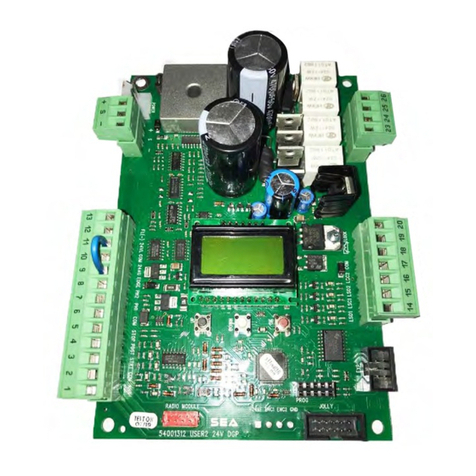
SEA
SEA USER 2 24V DG R1B ALL-IN User manual

SEA
SEA GATE 1 DG R1 User manual
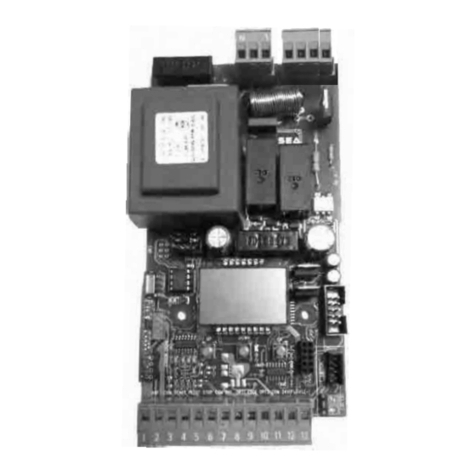
SEA
SEA SLIDE DG R2F User manual
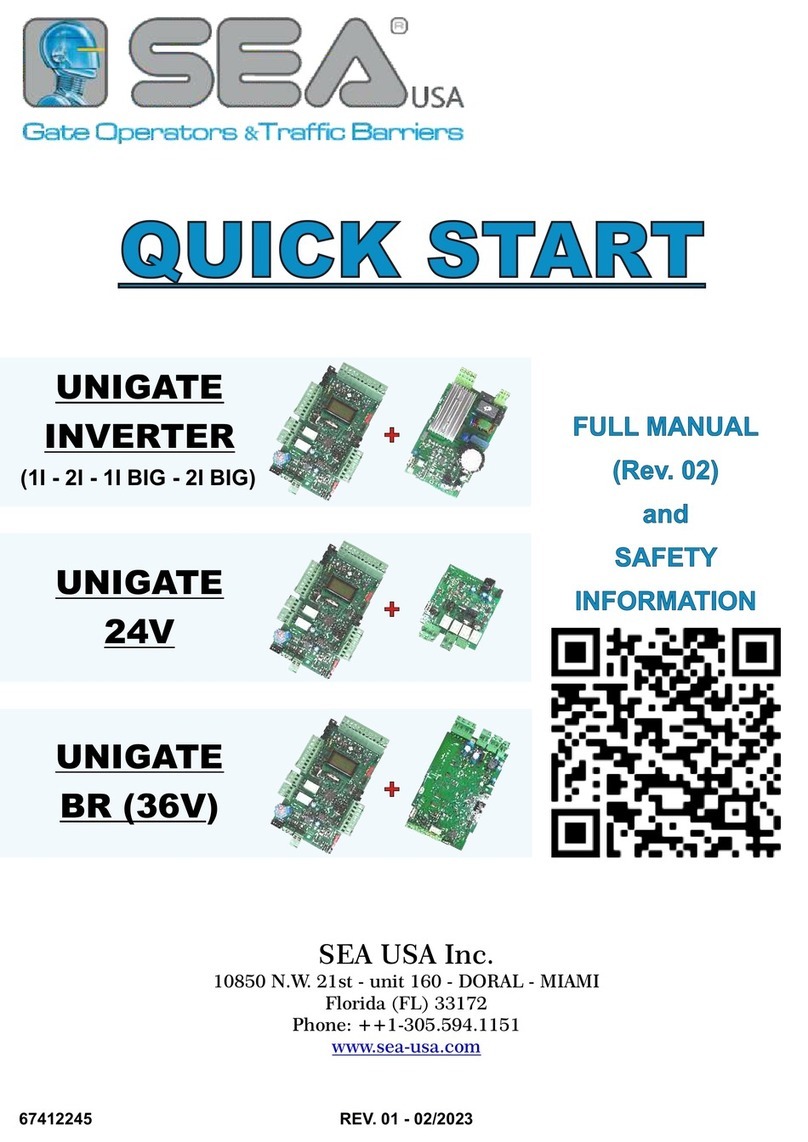
SEA
SEA UNIGATE 1I User manual
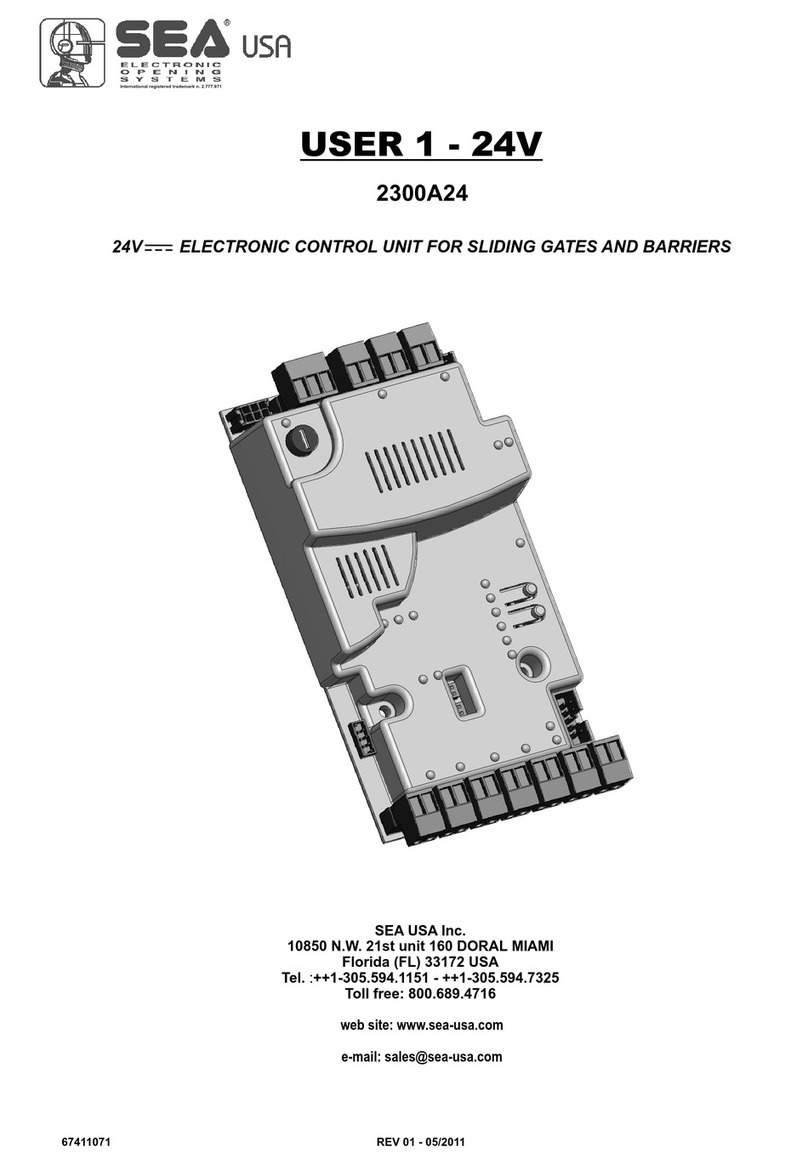
SEA
SEA USER 1-24V User manual

SEA
SEA SLIDE DG R2F User manual
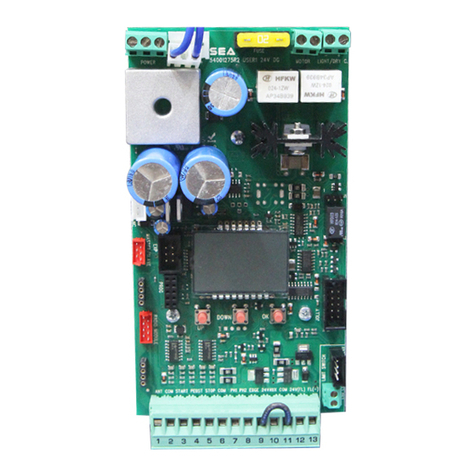
SEA
SEA USER 1 - 24v DG R1 User manual
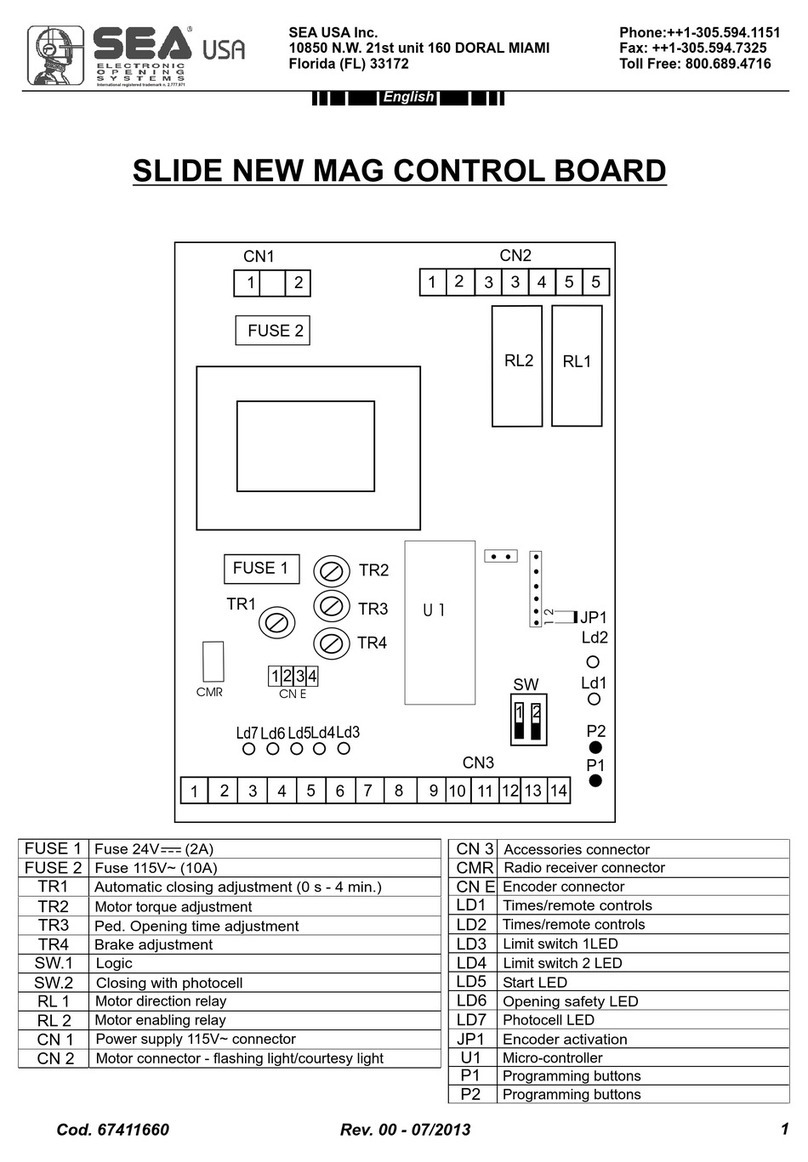
SEA
SEA SLIDE NEW MAG User manual

SEA
SEA 9521 User manual
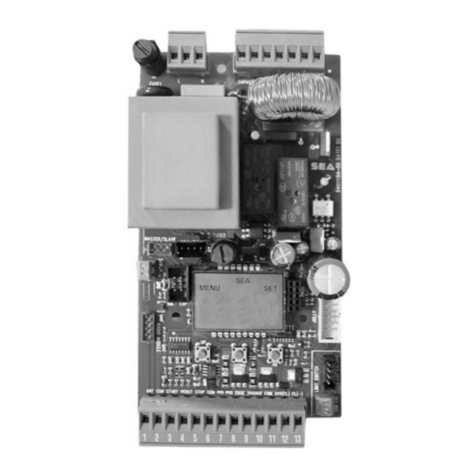
SEA
SEA GATE 1 DG R2BF User manual

SEA
SEA 23001157 User manual
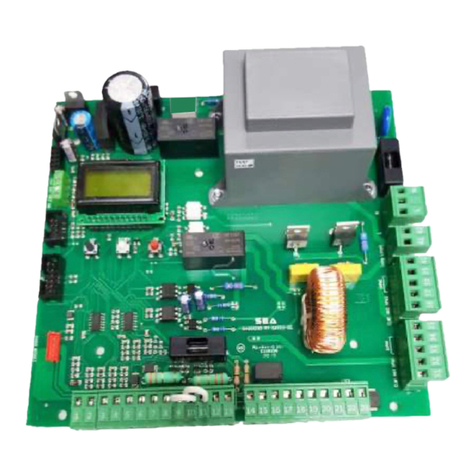
SEA
SEA GATE 2 DG R1B User manual

SEA
SEA USER1-24V User manual

SEA
SEA USER 1 - 24v DG R1 User manual

SEA
SEA GATE 1 DG R2BF User manual

SEA
SEA GATE 2 User manual
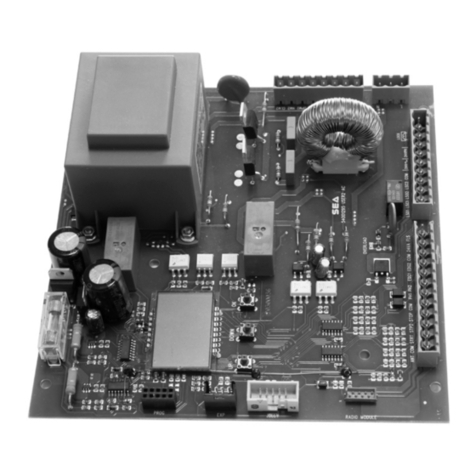
SEA
SEA GATE 1 DG R1 User manual

SEA
SEA GATE 1 DG R2BF User manual
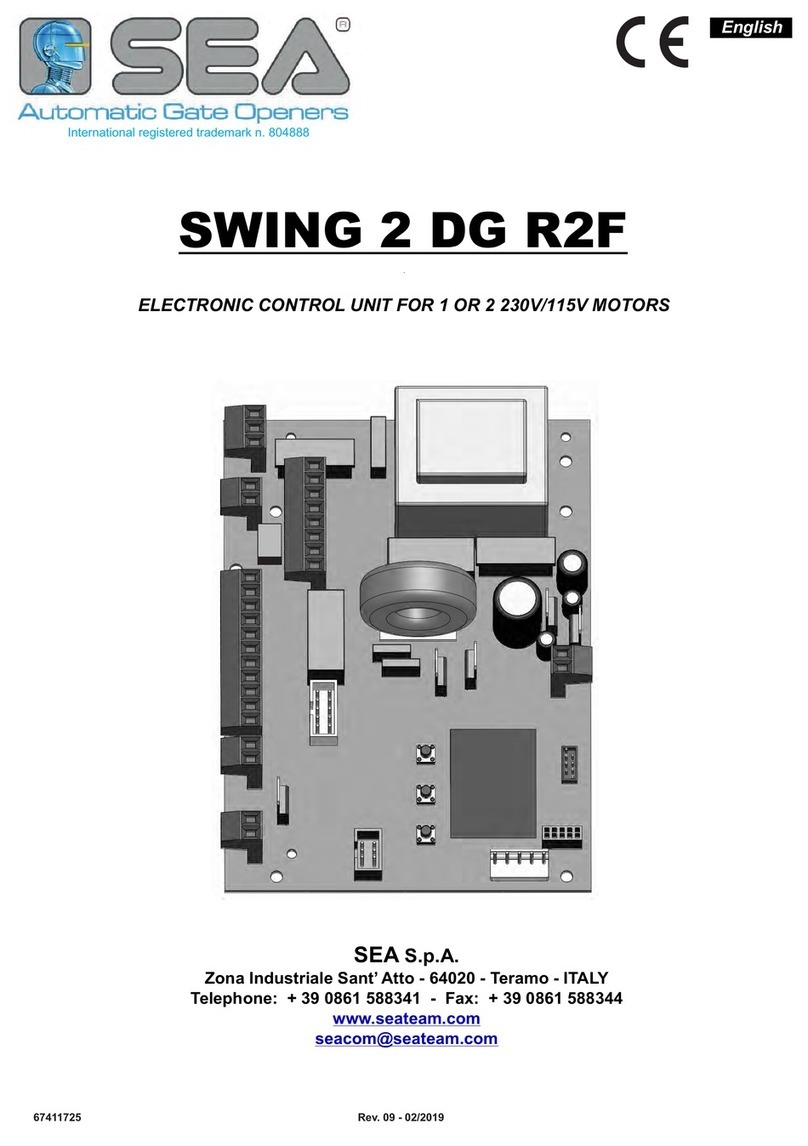
SEA
SEA SWING 2 DG R2F User manual

SEA
SEA GATE 1 DG R2BF User manual

